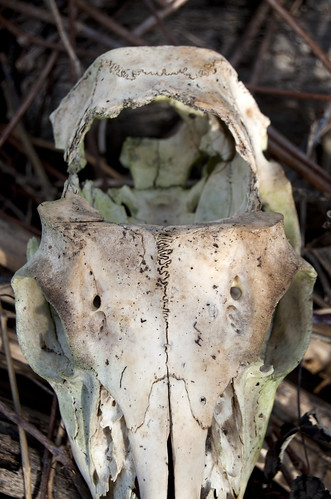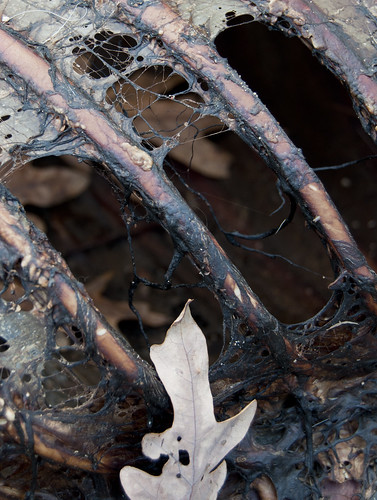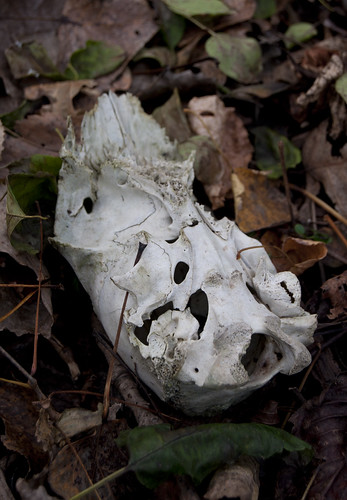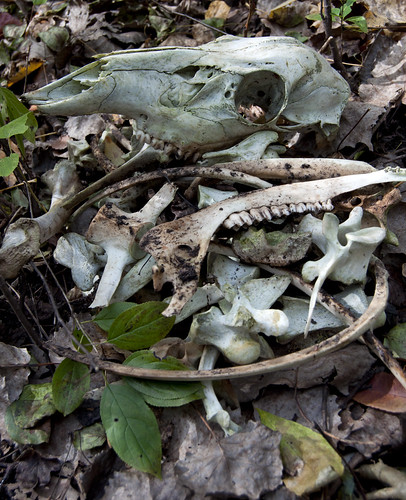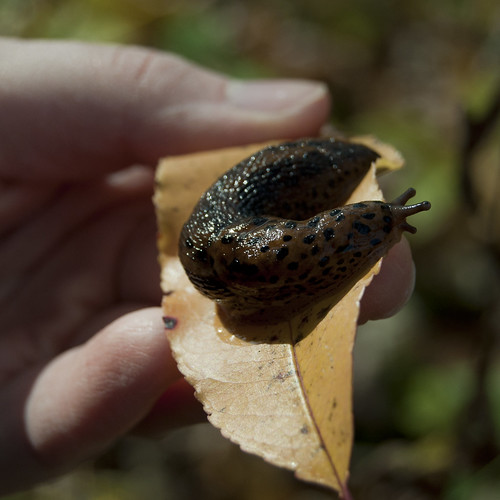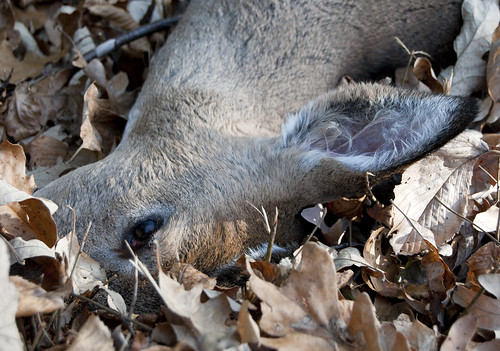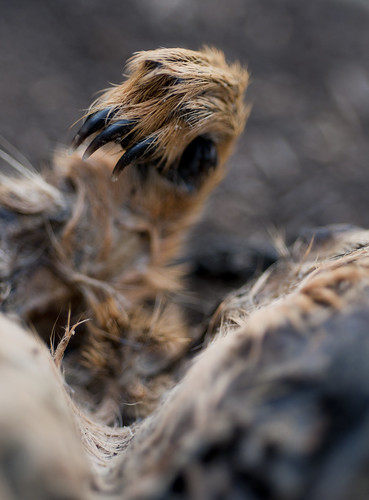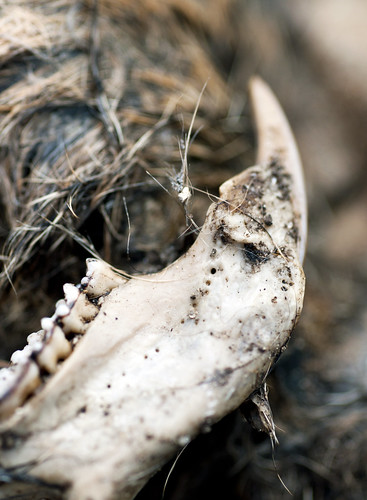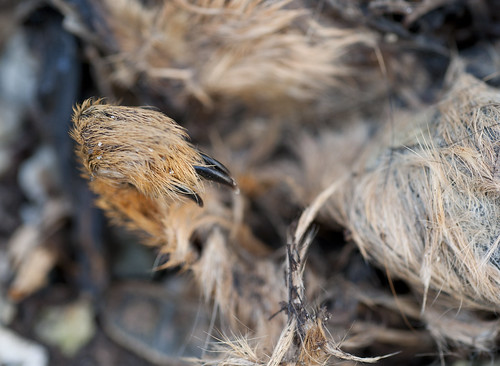Hunting is a sensitive subject for me; I both understand it and dislike it. As speciesist as it may be, I am much more open to the hunting of herbivores (such as deer) than that of carnivores (such as coyotes). And, having lived in the state of Michigan my entire life, I certainly understand the hype and celebration surrounding deer season. All that said, all opinions aside, hunting is completely within the law -- that is, if you're doing it legally.
This story isn't about natural deaths, nor is it about deer season -- it's about poaching, and a blatant disregard and disrespect for life and the law.
On Sunday morning, my dad and I drove out toward Pinckney to visit friend and fellow photographer Marc Akemann. About a week earlier, when I had been lamenting the lack of subject matter in Ann Arbor, Marc had suggested I visit, as his property borders the Brighton Recreation Area. He told me that he was finding dead animals all the time out there -- primarily, poached deer.
Upon arriving, the first spot we inspected was a parking area next to a small lake. As soon as I climbed out of the car, the stench of death hit me -- it was a very familiar odor, one that I'd not encountered in many years. It was the smell of recently-slaughtered, rotting deer. The bodies didn't take long to locate. The first two deer that we found had to have been killed within the past couple weeks -- one was extremely fresh: the fat and muscle on his exposed ribcage was glistening, and flies were flocking to his legs and face. The second was only slightly older; the fur had seemingly exploded from his head, creating a most bizarre scene:
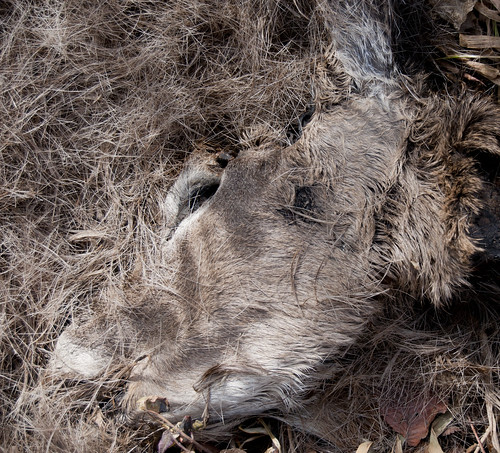
A third deer was found in the most disturbing of places: beneath a heap of garbage. The corpse had been hidden, but not very well, as a simple nudge of the trash uncovered the skull's ghastly smile:
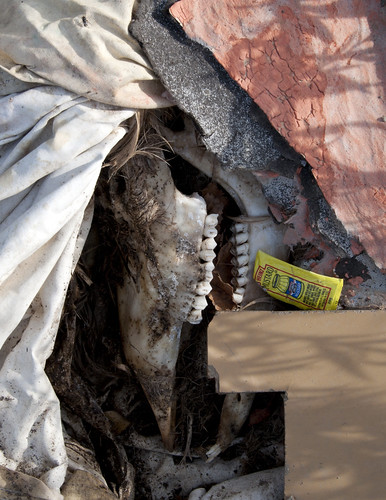
This deer, too, had not been there for more than a month or so. Skin and fur still clung to the skull, and the mountain of waste atop the body was trapping in the smell, and perhaps slowing decomposition. The deer's teeth, and that perceived grimace, was incredibly powerful to me. Combined with the trash and ditched mustard packet, the scene spoke volumes. Waste... disrespect... uselessness.


These deer were poached for meat and antlers. After those things were taken, the bodies were thrown into roadside ditches, hidden beneath piles of brush and garbage, and, in some cases, left behind in plain sight without a care in respect to life or the law. I did find the remains of two or three does (both yearling and adult), but the majority of the corpses belonged to bucks. Their antlers were cut from their heads, leaving behind grisly, gaping holes in the skulls.
This skull, bleached white and starting to grow green moss or algae, had been there for quite some time -- a few years, at the least -- and one must wonder just how many layers of poached deer line the parking lots and roadsides of this area.
Because there were so many bodies, lone skulls, and partial skeletons, it was hard for me to keep track of how many deer we encountered. At the lakeside parking area, I counted at least five deer, but it was probably closer to six or seven, all in various stages of decomposition. Marc showed us some other areas, and led us along a few trails through the (very beautiful) forest. We didn't encounter any ditched deer corpses in the woods, however -- we only found them along the roadsides. One such body, left in plain sight, had been decapitated. The tissue on its ribcage had turned dark, and falling leaves were starting to cover the corpse.
Though we probably saw more, I can specifically remember seeing the corpses, skulls, and skeletons of eleven separate deer. One of the last bodies we visited was one that Marc had found a year or two prior. It, like the others, had been dumped along the roadside. All that remained were the bones; the spinal column, though disarticulated, still rested in a row.
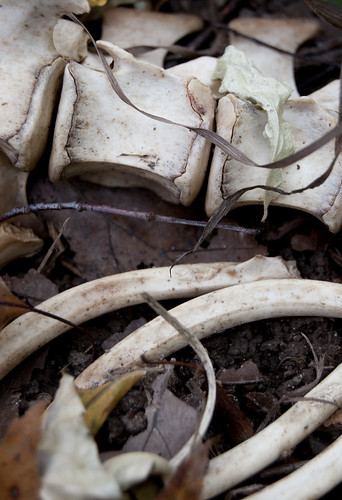
Nature, of course, treats these bodies like any other. They decay and fall apart; maggots squirm in the meager flesh left behind, and crows pick away at the skin and connective tissues. But at what cost?
I plan on returning to this area once rifle season has come and gone, as I'd like to do more extensive photography of the bodies, and try some different compositional techniques. I'd also like to shoot with film, in black and white. For this set, I attempted to follow my standard Useless Creatures rule of bringing out the beauty in the dead; however, it's terribly hard to bring beauty into something so evil and wasteful.
This skull, bleached white and starting to grow green moss or algae, had been there for quite some time -- a few years, at the least -- and one must wonder just how many layers of poached deer line the parking lots and roadsides of this area.
Because there were so many bodies, lone skulls, and partial skeletons, it was hard for me to keep track of how many deer we encountered. At the lakeside parking area, I counted at least five deer, but it was probably closer to six or seven, all in various stages of decomposition. Marc showed us some other areas, and led us along a few trails through the (very beautiful) forest. We didn't encounter any ditched deer corpses in the woods, however -- we only found them along the roadsides. One such body, left in plain sight, had been decapitated. The tissue on its ribcage had turned dark, and falling leaves were starting to cover the corpse.
Though we probably saw more, I can specifically remember seeing the corpses, skulls, and skeletons of eleven separate deer. One of the last bodies we visited was one that Marc had found a year or two prior. It, like the others, had been dumped along the roadside. All that remained were the bones; the spinal column, though disarticulated, still rested in a row.

Nature, of course, treats these bodies like any other. They decay and fall apart; maggots squirm in the meager flesh left behind, and crows pick away at the skin and connective tissues. But at what cost?
I plan on returning to this area once rifle season has come and gone, as I'd like to do more extensive photography of the bodies, and try some different compositional techniques. I'd also like to shoot with film, in black and white. For this set, I attempted to follow my standard Useless Creatures rule of bringing out the beauty in the dead; however, it's terribly hard to bring beauty into something so evil and wasteful.

